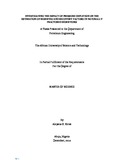| dc.contributor.author | Aloysius, K. Kotee | |
| dc.date.accessioned | 2016-10-25T11:41:55Z | |
| dc.date.available | 2016-10-25T11:41:55Z | |
| dc.date.issued | 2014-12-20 | |
| dc.identifier.uri | http://repository.aust.edu.ng/xmlui/handle/123456789/510 | |
| dc.identifier.uri | http://library.aust.edu.ng:8080/xmlui/handle/123456789/510 | |
| dc.description.abstract | The complexity of naturally fractured reservoirs poses constrains on reservoir engineers in estimating reserves and recovery factor in naturally fractured reservoirs. Naturally fractured reservoirs like all other hydrocarbon reservoirs are subject to uncertainties. This paper analyzes the impact of pressure depletion on the estimation of reserves and recovery factors in naturally fractured reservoirs (NFRs).
Fluids in naturally fractured reservoir are stored both in matrix and fracture pore volumes where the volumetric fraction of the reservoir fluids stored in fracture is indicated by the storage capacity ratio, Chacon and Tiab. Changes in reservoir pore pressure due to production or injection of fluids affect the fracture and matrix pores compressibilities; and storage capacity ratio. The mechanical behavior of matrix and fracture rocks properties due to change in pore pressure has significant impact on reserves estimate and recovery factor. But current analyses for quantifying reserves in naturally fractured reservoirs based on the general material balance equation (GMBE), consider the behavior of naturally fractured reservoirs to be similar to homogeneous reservoirs; i.e., fracture and matrix pore volume compressibilities are assumed to be equal. This wrongful assumption has led to significant errors in estimating reserves and recovery factor, risks optimum reservoir management and the prediction of reservoir future performance. However, in an effort to reduce this significant error, a complete treatment of the material balance model for naturally fractured reservoirs has been developed by Chacon and Tiab [1] . Chacon and Tiab’s proposed material balance equation to compute hydrocarbons in place and fractional recovery were developed for both undersaturated and saturated naturally fractured reservoirs (NFRs). The equation was treated in such that fracture and matrix storage capacity ratio was integrated into the equation with a new plotting scheme for better estimation of oil in place. Chacon and Tiab’s proposed material balance equation for naturally fractured reservoirs was adapted in this research. Well test data of volumetric undersaturated and saturated naturally fractured reservoirs were analyzed based on 4 cases of storage capacity ratio. Fracture and matrix pore volume compressibility ratio was neglected for each case and later considered for each case as well.
The results were compared and analyzed. Computations shows that in volumetric undersaturated naturally fractured reservoirs, error differences greater than 10% are expected when estimating recovery factors if differences between the fracture and matrix pore compressibility are not taken into account. The percent differences in estimating recovery factors is directly proportional to storage capacity ratio.
In volumetric saturated NFRs, a reservoir with high storage capacity ratio producing at constant rate in line with a reservoir of low storage capacity ratio is expected to deplete it reserve sooner as compare to a reservoir with low storage capacity ratio due to high recovery factor. | en_US |
| dc.description.sponsorship | AUST/ADB | en_US |
| dc.language.iso | en | en_US |
| dc.subject | Aloysius K. Kotee | en_US |
| dc.subject | Prof. Djebba Tiab | en_US |
| dc.subject | Impact of Pressure Depletion | en_US |
| dc.subject | Naturally Fractured Reservoirs | en_US |
| dc.subject | Recovery | en_US |
| dc.subject | Reserves | en_US |
| dc.subject | 2014 Petroleum Engineering | en_US |
| dc.title | Investigating the Impact of Pressure Depletion on the Estimation of Reserves and Recovery Factors in Naturally Fractured Reservoirs | en_US |
| dc.type | Thesis | en_US |

